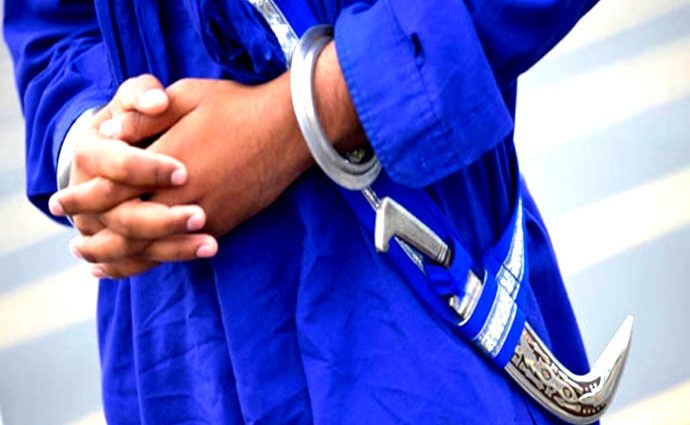After the unfortunate incident in Sydney’s Glenwood High School when a 14 years old Sikh Boy allegedly stabbed a 16 years old student twice in stomach, the New South Wales moving swiftly banned carrying kirpan or any form of knife to school, even for genuine religious purposes in all government schools in New South Wales.
This quick announcement was made while the NSW government takes time to consider its detailed response after the “critical incident” which had “raised some very legitimate questions around the legislation”, in particular the Summary Offences Act which allows a person to carry a knife in public, provided they have a “reasonable excuse”, according to the state Education minister Sarah Mitchell.
“That’s why we’ve made a commitment to review that legislation and look at what changes we need to make, just to ensure that the safety of students and staff comes first,” Ms Mitchell said.
The 14 years old Sikh boy has been charged with two counts of wounding a person with intent to cause grievous bodily harm. He is on bail and is due back in court in July.
The other boy injured in the incident spent 11 days in hospital before being released to recuperate at home.
Hosting a debate on the issues highlighted by the incident on Channel Nine, the Today show host Karl Stefanovic described it as a ‘difficult’ issue, adding it was “school safety versus religious freedom”.
However, broadcaster Chris Smith then chimed in and said “you don’t put knives in the hands of immature human beings”.
“I don’t think it’s hard, it’s not 1621, it’s 2021, it is Australia, it is modern day,” he said.
“What sort of backward religious belief is this in the modern day? It’s dangerous.”
The question is – Is it helpful to label a religion ‘backward’ after one incident?The short answer is “NO”.
But the bigger picture issue of placing a ban on kirpan needs a very sensible and closer look by some of Australia’s best legal minds.
In 2006, Denmark became the first country in the world to ban wearing of kirpans.
In 2017, Italy also joined Denmark when its Court of Cassation (Italian Supreme Court), the court of last resort sitting at Palace of Justice in Rome ruled that a Sikh man was not allowed to carry a knife considered sacred by his religion in public.
In the same year Canadian Supreme Court had allowed wearing of kirpan by a student if it is sealed and secured. But
“The Supreme Court of Canada said banning the religious item violated the country’s Charter of Rights and Freedoms.
Students there are allowed to carry a kirpan if it is sealed and secured.”
Italy’s Court of Cassation ruled on Monday that a Sikh man was not allowed to carry a knife considered sacred by his religion in public.
The Italian Supreme Court, while delivering its ruling, said immigrants in the country had an obligation to integrate with Western culture. “An attachment to one’s own values, even if they are lawful in the country of origin, is intolerable when it causes violating the laws of the host country,” the court had said, reported the Italian news agency ANSA at the time.
“A multi-ethnic society is a necessity, but it can’t lead to the formation of conflicting cultural groups…precluding the unity of the cultural and judicial fabric of our country, which identifies public safety as an asset to defend and as such bans carrying weapons and objects aimed at injury.” the court had added.
While the NSW government looks at the relevant legislation for amendments and updates, the related questions of immigrants’ integration and the make-up of society in the host country raised above perhaps completely unnecessary in the current case will inevitably come up.
Then the question for our community will be – has this incident invited an unwelcome botheration to the thus far peaceful, successful integration of the Australian Indian community?
Suddenly the focus is on us, but in a different light altogether. There have been infighting amongst our youth in Sydney – which may seniors claim has been wrongly painted by various interest groups, some even alleging CIA hand but we have been in the spotlight in New South Wales.
This single incident can allow a very different take on things.
Many in the community take solace from a 2006 judgement of Canadian Supreme Court where the court reversed the ban on a student who wanted to come to schools wearing it for religious reasons. The court allowed the wearing of kirpan provided it was sealed and secure and posed no danger. The judgement mentioned the Sikh community’s existence in Canada for over hundred years and no such incident had taken place.
“The young Sikh is authorized to wear his kirpan, which, while a kind of “knife”, is above all a religious object whose dangerous nature is neutralized by the many coverings required by the Superior Court. The kirpan must be enclosed in a wooden sheath and the sheath must be sewn inside a cloth envelope, which must itself be attached to a shoulder strap worn under the student’s clothing. Secured in this way, the kirpan is almost totally stripped of its objectively dangerous characteristics”, the Canadian Supreme Court had said.
“Access to the kirpan is not merely delayed, it is now fully impeded by the cloth envelope sewn around the wooden sheath. In these circumstances, the argument relating to safety can no longer reasonably succeed”.
Also read: First Sikh School in Southern Hemisphere
This is how the kirpan in Canada was allowed and the court noted that the father and the student in that case had actually made that offer to the school to keep observing their religious practice and beliefs.
But the school had refused to allow that accommodation.
Observing the school not only had the obligation to ensure safety and protection of students and third parties, the court said, “It is possible that a justification (of banning the wearing of kirpan) could be found in the need to fulfil such obligations”.
The court observed: “…the evidence revealed no instances of violent incidents involving kirpans in schools in Quebec”.
“In fact, the evidence in the record suggests that, over the 100 years since Sikhs have been attending schools in Canada, not a single violent incident related to the presence of kirpans in schools has been reported.”
Thus the Court “must conclude that the respondent school board has not shown that its prohibition was justified” – considering the student (and his father) had offered to wear it the way (described above) where the kirpan would be totally stripped of its dangerous characteristics
The question for the leaders here in Australia is to ponder over the case – with close attention to the detailed reasons given in the judgement.
The incident in Sydney kills the whole thesis which was the very foundation of the Canadian Supreme Court judgement.
The way the kirpan was being worn at the time of the incident, the easy and quick access to for the boy to twice stab the victim, will be argued to justify any proposed law in NSW. Needless to say other states and authorities may follow suit.
Similar Posts by The Author:
- To save the Labor party’s chances, it is imperative Anthony Albanese exits
- Has Justin Trudeau sunk India-Canada bilateral relations to the point of ‘beyond repair’?
- Fatima Payman’s ‘Australia’s Voice’ – Lessons from Kaushaliya Vaghela’s Vic Labor stint
- Haryana puts Rahul Gandhi back in the box
- Dr TJ Rao OAM, a legend will live on

